2015 NISSAN GT-R light
[x] Cancel search: lightPage 57 of 358
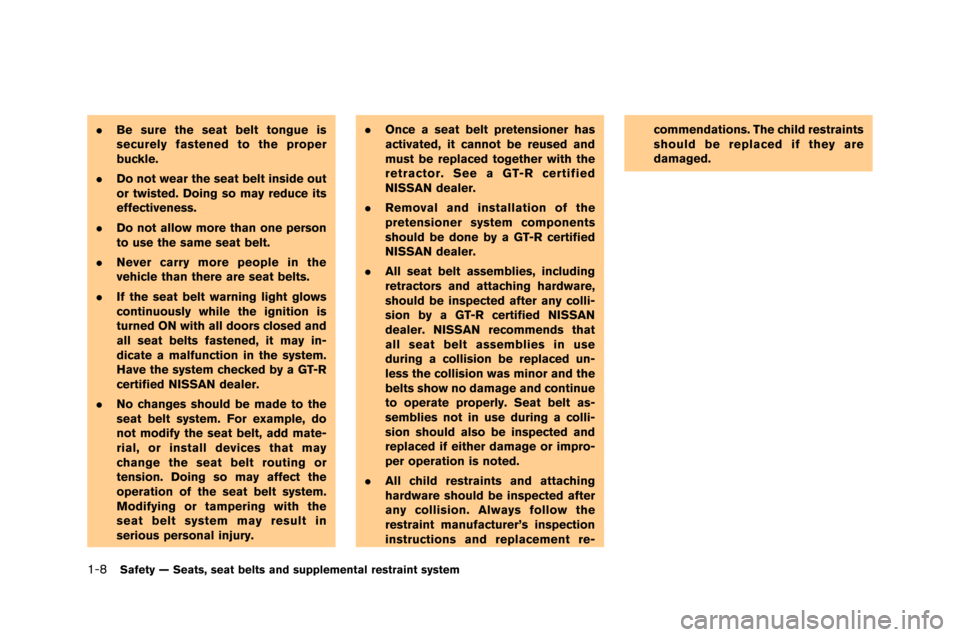
1-8Safety — Seats, seat belts and supplemental restraint system
.Be sure the seat belt tongue is
securely fastened to the proper
buckle.
. Do not wear the seat belt inside out
or twisted. Doing so may reduce its
effectiveness.
. Do not allow more than one person
to use the same seat belt.
. Never carry more people in the
vehicle than there are seat belts.
. If the seat belt warning light glows
continuously while the ignition is
turned ON with all doors closed and
all seat belts fastened, it may in-
dicate a malfunction in the system.
Have the system checked by a GT-R
certified NISSAN dealer.
. No changes should be made to the
seat belt system. For example, do
not modify the seat belt, add mate-
rial, or install devices that may
change the seat belt routing or
tension. Doing so may affect the
operation of the seat belt system.
Modifying or tampering with the
seat belt system may result in
serious personal injury. .
Once a seat belt pretensioner has
activated, it cannot be reused and
must be replaced together with the
retractor. See a GT-R certified
NISSAN dealer.
. Removal and installation of the
pretensioner system components
should be done by a GT-R certified
NISSAN dealer.
. All seat belt assemblies, including
retractors and attaching hardware,
should be inspected after any colli-
sion by a GT-R certified NISSAN
dealer. NISSAN recommends that
all seat belt assemblies in use
during a collision be replaced un-
less the collision was minor and the
belts show no damage and continue
to operate properly. Seat belt as-
semblies not in use during a colli-
sion should also be inspected and
replaced if either damage or impro-
per operation is noted.
. All child restraints and attaching
hardware should be inspected after
any collision. Always follow the
restraint manufacturer’s inspection
instructions and replacement re- commendations. The child restraints
should be replaced if they are
damaged.
Page 60 of 358
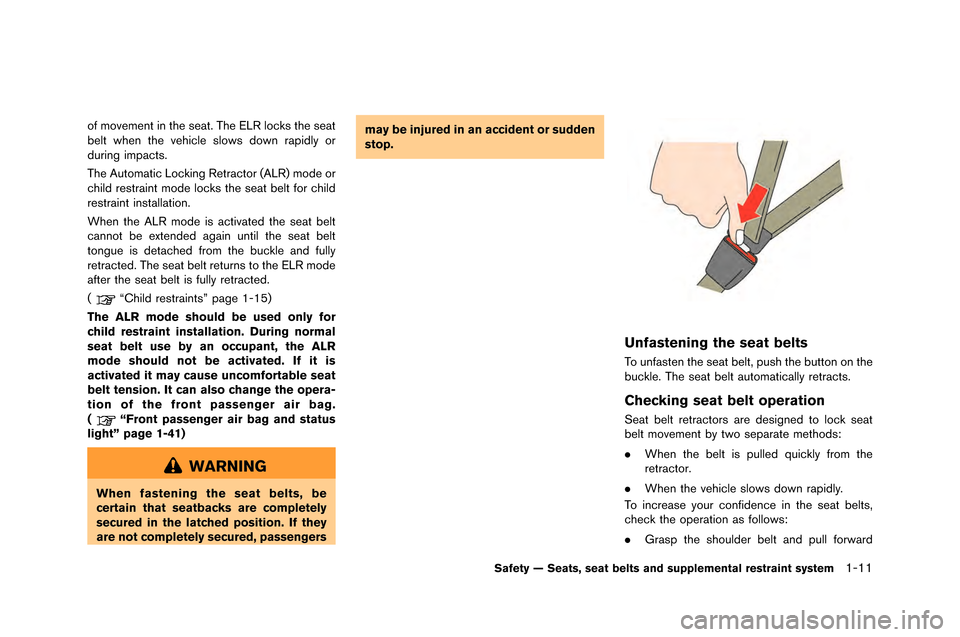
of movement in the seat. The ELR locks the seat
�felt when the vehicle slows down ra�bidly or
during im�bacts.
The Automatic Locking Retractor (ALR) mode or
child restraint mode locks the seat �felt for child
restraint installation.
When the ALR mode is activated the seat �felt
cannot �fe extended again until the seat �felt
tongue is detached from the �fuckle and fully
retracted. The seat �felt returns to the ELR mode
after the seat �felt is fully retracted.
(
“Child restraints” �bage 1-15)
The ALR mode should be used only for
child restraint installation. During normal
seat belt use by an occupant, the ALR
mode should not be activated. If it is
activated it may cause uncomfortable seat
belt tension. It can also change the opera-
tion of the front passenger air bag.
(
“Front passenger air bag and status
light” page 1-41)
WARNING
When fastening the seat belts, be
certain that seatbacks are completely
secured in the latched position. If they
are not completely secured, passengers may be injured in an accident or sudden
stop.
Unfastening the seat belts
To unfasten the seat �felt, �bush the �futton on the
�fuckle. The seat �felt automatically retracts.
Checking seat belt operation
Seat �felt retractors are designed to lock seat
�felt movement �fy two se�barate methods:
.
When the �felt is �bulled quickly from the
retractor.
. When the vehicle slows down ra�bidly.
To increase your confidence in the seat �felts,
check the o�beration as follows:
. Gras�b the shoulder �felt and �bull forward
Safety — Seats, seat belts and supplemental restraint system1-11
Page 70 of 358

5. Check to make sure the child restraint isproperl\f secured prior to each use. If the
child restraint is loose, repeat steps \b
through 4.
REAR-FACING CHILD RESTRAINT
INSTALLATION USING THE SEAT
BELTS
WARNING
The three-point seat belt with Auto-
matic Locking Retractor (ALR) must be
used when installing a child restraint.
Failure to use the ALR mode will result
in the child restraint not being properly
secured. The restraint could tip over or
be loose and cause injury to a child in a
sudden stop or collision. Also, it can change the operation of the front
passenger air bag. See “Front passen-
ger air bag and status light” later in this
section.
Safety — Seats, seat belts and supplemental restraint system\b-2\b
Page 76 of 358
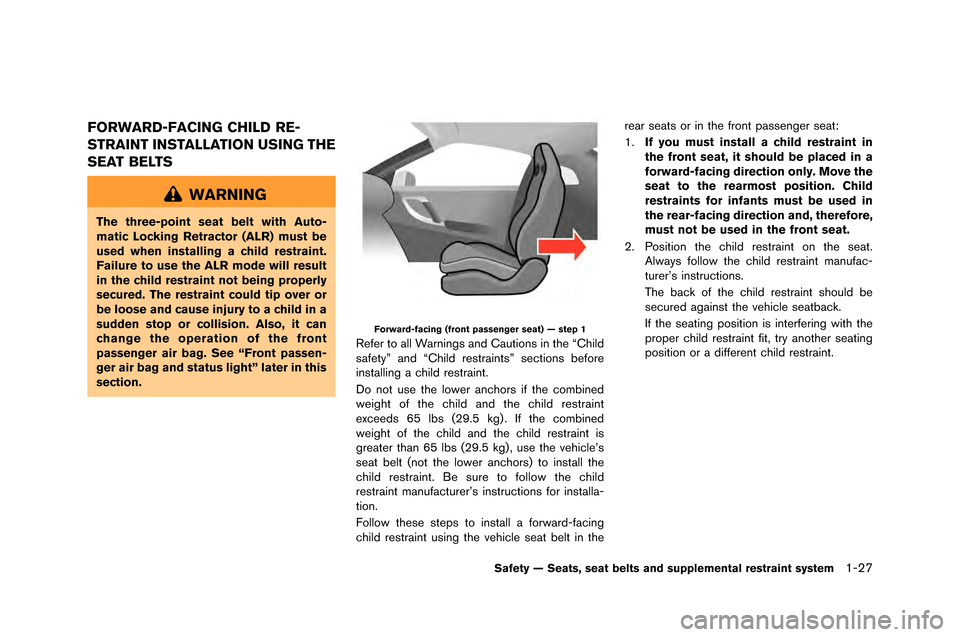
FORWARD-FACING CHILD RE-
STRAINT INSTALLATION USING THE
SEAT BELTS
WARNING
The three-point seat belt with Auto-
matic Locking Retractor (ALR) must be
used when installing a child restraint.
Failure to use the ALR mode will result
in the child restraint not being properly
secured. The restraint could tip over or
be loose and cause injury to a child in a
sudden stop or collision. Also, it can
change the operation of the front
passenger air bag. See “Front passen-
ger air bag and status light” later in this
section.
Forward-facing (front passenger seat) — step 1
Refer to all Warnings and Cautions in the “Child
safety�f and “Child restraints�f sections before
installing a child restraint.
�bo not use the lower anchors if the combined
weight of the child and the child restraint
exceeds 65 lbs (29.5 kg) . If the combined
weight of the child and the child restraint is
greater than 65 lbs (29.5 kg) , use the vehicle’s
seat belt (not the lower anchors) to install the
child restraint. Be sure to follow the child
restraint manufacturer’s instructions for installa-
tion.
Follow these steps to install a forward-facing
child restraint using the vehicle seat belt in therear seats or in the front passenger seat:
1.
If you must install a child restraint in
the front seat, it should be placed in a
forward-facing direction only. Move the
seat to the rearmost position. Child
restraints for infants must be used in
the rear-facing direction and, therefore,
must not be used in the front seat.
2. Position the child restraint on the seat. Always follow the child restraint manufac-
turer’s instructions.
The back of the child restraint should be
secured against the vehicle seatback.
If the seating position is interfering with the
proper child restraint fit, try another seating
position or a different child restraint.
Safety — Seats, seat belts and supplemental restraint system1-27
Page 79 of 358
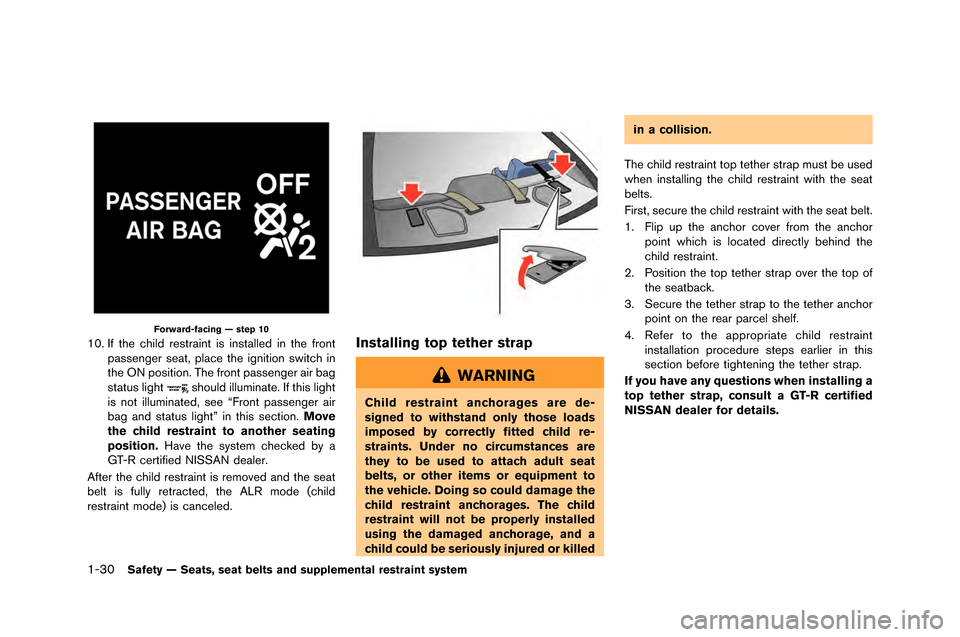
1-30Safety — Seats, seat belts and supplemental restraint system
Forward-facing — step 10
10. If the child restraint is installed in the front�fassenger seat, �flace the ignition switch in
the �bN �fosition. The front �fassenger air bag
status light
should illuminate. If this light
is not illuminated, see “Front �fassenger air
bag and status light” in this section. Move
the child restraint to another seating
position. Have the system checked by a
GT-R certified NISSAN dealer.
After the child restraint is removed and the seat
belt is fully retracted, the ALR mode (child
restraint mode) is canceled.
Installing top tether strap
WARNING
Child restraint anchorages are de-
signed to withstand only those loads
imposed by correctly fitted child re-
straints. Under no circumstances are
they to be used to attach adult seat
belts, or other items or equipment to
the vehicle. Doing so could damage the
child restraint anchorages. The child
restraint will not be properly installed
using the damaged anchorage, and a
child could be seriously injured or killed in a collision.
The child restraint to�f tether stra�f must be used
when installing the child restraint with the seat
belts.
First, secure the child restraint with the seat belt.
1. Fli�f u�f the anchor cover from the anchor �foint which is located directly behind the
child restraint.
2. Position the to�f tether stra�f over the to�f of the seatback.
3. Secure the tether stra�f to the tether anchor �foint on the rear �farcel shelf.
4. Refer to the a�f�fro�friate child restraint installation �frocedure ste�fs earlier in this
section before tightening the tether stra�f.
If you have any questions when installing a
top tether strap, consult a GT-R certified
NISSAN dealer for details.
Page 83 of 358
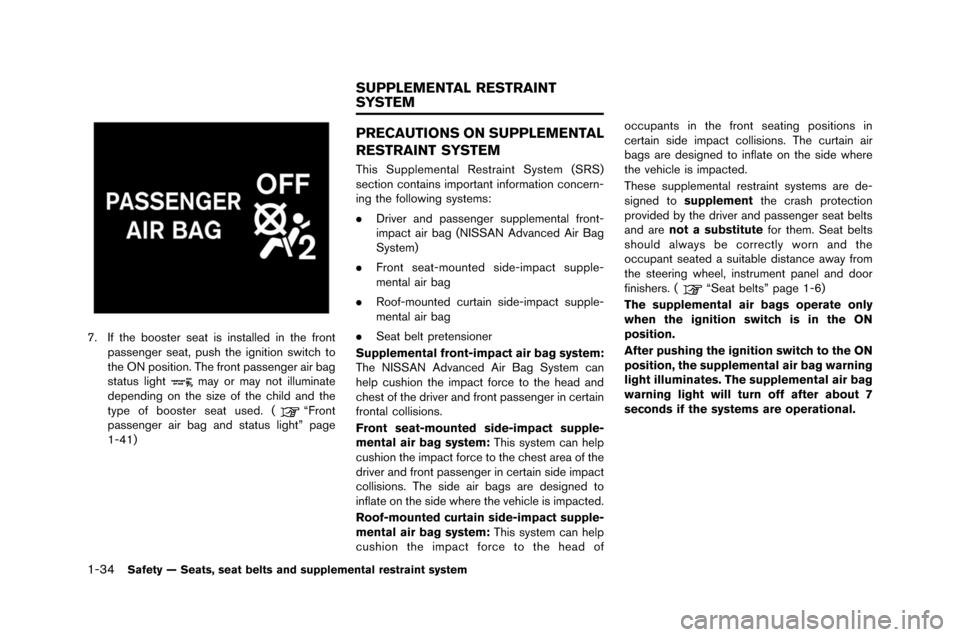
1-34Safety — Seats, seat belts and supplemental restraint system
7. If the booster seat is installe�f in the frontpassenger seat, p�bsh the ignition switch to
the ON position. The front passenger air bag
stat�bs light
may or may not ill�bminate
�fepen�fing on the size of the chil�f an�f the
type of booster seat �bse�f. (
“Front
passenger air bag an�f stat�bs light” page
1-41)
PRECAUTIONS ON SUPPLEMENTAL
RESTRAINT SYSTEM
This S�bpplemental Restraint System (SRS)
section contains important information concern-
ing the following systems:
. Driver an�f passenger s�bpplemental front-
impact air bag (NISSAN A�fvance�f Air Bag
System)
. Front seat-mo�bnte�f si�fe-impact s�bpple-
mental air bag
. Roof-mo�bnte�f c�brtain si�fe-impact s�bpple-
mental air bag
. Seat belt pretensioner
Supplemental front-impact air bag system:
The NISSAN A�fvance�f Air Bag System can
help c�bshion the impact force to the hea�f an�f
chest of the �friver an�f front passenger in certain
frontal collisions.
Front seat-mounted side-impact supple-
mental air bag system: This system can help
c�bshion the impact force to the chest area of the
�friver an�f front passenger in certain si�fe impact
collisions. The si�fe air bags are �fesigne�f to
inflate on the si�fe where the vehicle is impacte�f.
Roof-mounted curtain side-impact supple-
mental air bag system: This system can help
c�bshion the impact force to the hea�f of occ�bpants in the front seating positions in
certain si�fe impact collisions. The c�brtain air
bags are �fesigne�f to inflate on the si�fe where
the vehicle is impacte�f.
These s�bpplemental restraint systems are �fe-
signe�f to
supplement the crash protection
provi�fe�f by the �friver an�f passenger seat belts
an�f are not a substitute for them. Seat belts
sho�bl�f always be correctly worn an�f the
occ�bpant seate�f a s�bitable �fistance away from
the steering wheel, instr�bment panel an�f �foor
finishers. (
“Seat belts” page 1-6)
The supplemental air bags operate only
when the ignition switch is in the ON
position.
After pushing the ignition switch to the ON
position, the supplemental air bag warning
light illuminates. The supplemental air bag
warning light will turn off after about 7
seconds if the systems are operational.
SUPPLEMENTAL RESTRAINT
SYSTEM
Page 84 of 358
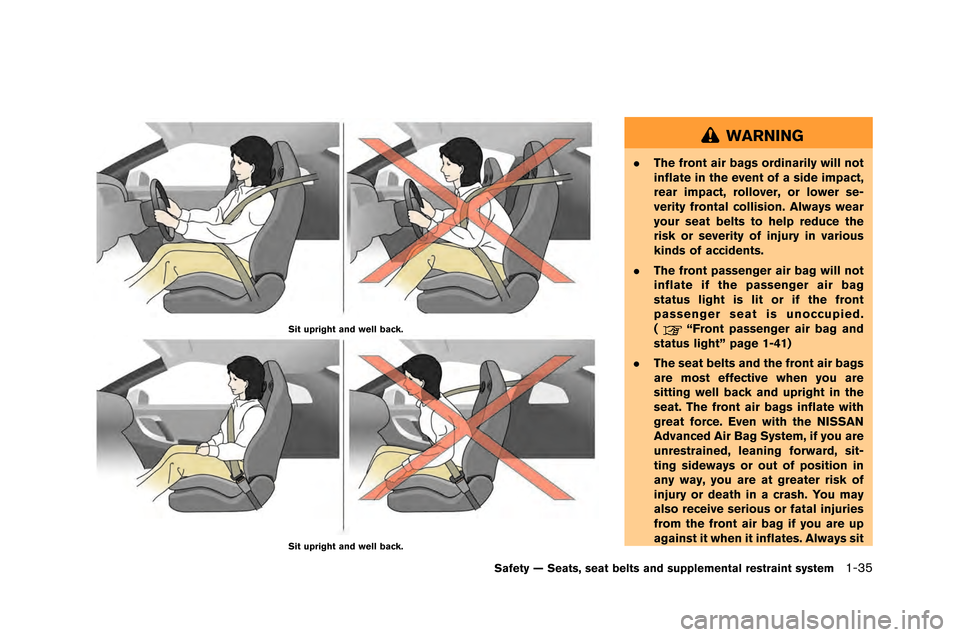
Sit upright and well back.
Sit upright and well back.
WARNING
.The front air bags ordinarily will not
inflate in the event of a side impact,
rear impact, rollover, or lower se-
verity frontal collision. Always wear
your seat belts to help reduce the
risk or severity of injury in various
kinds of accidents.
. The front passenger air bag will not
inflate if the passenger air bag
status light is lit or if the front
passenger seat is unoccupied.
(
“Front passenger air bag and
status light” page 1-41)
. The seat belts and the front air bags
are most effective when you are
sitting well back and upright in the
seat. The front air bags inflate with
great force. Even with the NISSAN
Advanced Air Bag System, if you are
unrestrained, leaning forward, sit-
ting sideways or out of position in
any way, you are at greater risk of
injury or death in a crash. You may
also receive serious or fatal injuries
from the front air bag if you are up
against it when it inflates. Always sit
Safety — Seats, seat belts and supplemental restraint system1-35
Page 85 of 358
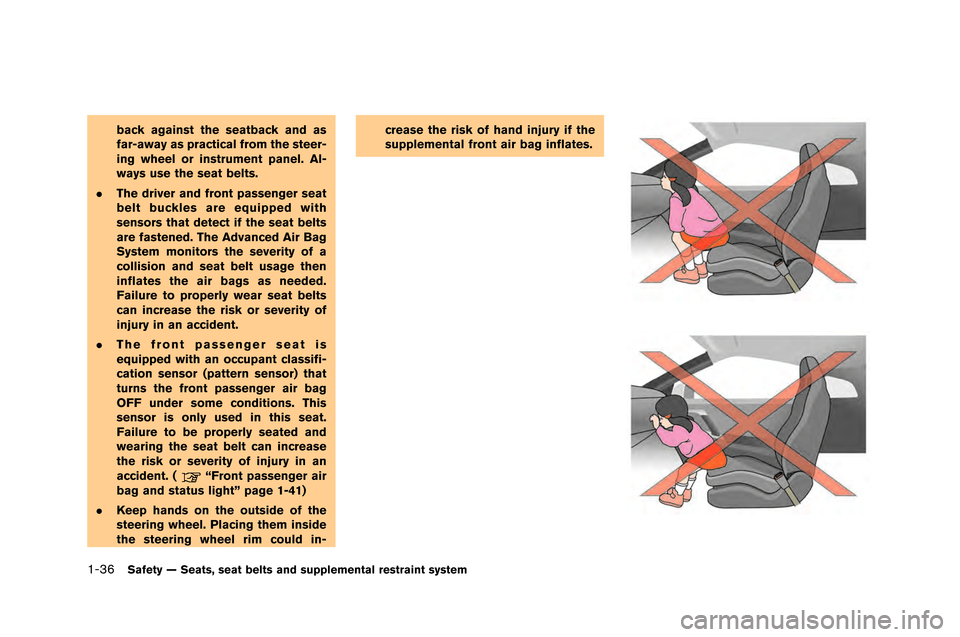
1-36Safety — Seats, seat belts and supplemental restraint system
back against the seatback and as
far-away as practical from the steer-
ing wheel or instrument panel. Al-
ways use the seat belts.
. The driver and front passenger seat
belt buckles are equipped with
sensors that detect if the seat belts
are fastened. The Advanced Air Bag
System monitors the severity of a
collision and seat belt usage then
inflates the air bags as needed.
Failure to properly wear seat belts
can increase the risk or severity of
injury in an accident.
. The front passenger seat is
equipped with an occupant classifi-
cation sensor (pattern sensor) that
turns the front passenger air bag
OFF under some conditions. This
sensor is only used in this seat.
Failure to be properly seated and
wearing the seat belt can increase
the risk or severity of injury in an
accident. (
“Front passenger air
bag and status light” page 1-41)
. Keep hands on the outside of the
steering wheel. Placing them inside
the steering wheel rim could in- crease the risk of hand injury if the
supplemental front air bag inflates.